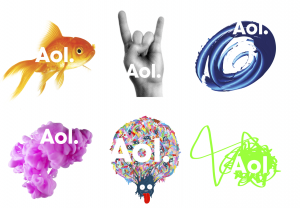What’s In A Brand? AOL Becomes “Aol.”
One wonders how much the branding consultancy Wolff Olins was paid to help create America Online’s new “brand identity.” Over the weekend the about-to-be-independent company revealed its new brand and brand philosophy. The major change (so far) is the move from uppercase to lowercase letters: from “AOL” to “Aol.” Here’s how the release describes that […]
One wonders how much the branding consultancy Wolff Olins was paid to help create America Online’s new “brand identity.” Over the weekend the about-to-be-independent company revealed its new brand and brand philosophy. The major change (so far) is the move from uppercase to lowercase letters: from “AOL” to “Aol.” Here’s how the release describes that new identity:
The new AOL brand identity is a simple, confident logotype, revealed by ever-changing images. It’s one consistent logo with countless ways to reveal. The new brand identity will be fully unveiled on December 10, when AOL common stock begins trading on the New York Stock Exchange.
“Our new identity is uniquely dynamic. Our business is focused on creating world-class experiences for consumers and AOL is centered on creative and talented people – employees, partners, and advertisers. We have a clear strategy that we are passionate about and we plan on standing behind the AOL brand as we take the company into the next decade,” said Tim Armstrong, Chairman and Chief Executive Officer of AOL.
Unlike Yahoo, which is also seeking to reinvigorate its brand with a multi-million dollar media campaign, “Aol.” will not be spending big dollars on a media campaign. (The “.” is part of the name, like the “!” at the end of Yahoo.)
According to CEO Tim Armstrong the company will promote its new identity on its own pages mostly. He told PaidContent that the campaign will be “very, very, very inexpensive because we’re focused on just improving the products and services. I would say the marketing budget is the budget we’re using on product development and the changes we’re making.”
This is wise. Aol needs to focus on its content and user experiences across its vast online territories rather than spending loads of money on TV and online display advertising. Just the same, one could argue that brands online matter now more than ever. Aol does need to stand in consumers’ minds for something. The company needs to answer the question “why Aol?” given how many sources of content, tools and information are out there.
A decade ago it was the dominant internet “portal” and destination of the day. But over time and through some neglect the brand became stale and associated with unsophisticated users: “training wheels for the internet.” The company later developed an ambivalent attitude toward “AOL,” pushing independent brands such as Platform A, Moviefone, PopEater, Engadget, MapQuest, GameDaily, TMZ, Truveo, MediaGlow (among others) to minimize or avoid the “newbie” stigma.
Is Aol like Proctor & Gamble or a magazine publisher, which has a portfolio of consumer brands or is it more like Apple, which has a single brand identity with a number of products in the market? Some version of this question must be answered.
Aol has decided the company is going to emphasize “content.” That necessarily involves a balance between cultivating individual brands as destinations online and, if the Aol brand isn’t going to be totally subordinated, some positioning of the parent brand in relation to those content brands.
And then there’s AOL search and where that fits into the strategy, but we’ll leave that for later.
Opinions expressed in this article are those of the guest author and not necessarily Search Engine Land. Staff authors are listed here.
Related stories
New on Search Engine Land
